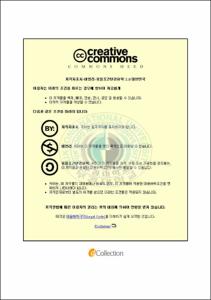The Preparation and Characterization of Metal Nanoparticle and Metal/SiO₂ Nanocomposites
- Alternative Title
- 금속나노입자와 금속/실리카 나노복합체의 합성 및 특성연구
- Abstract
- 본 연구에서 나노입자를 두 방법에 의하여 합성하였다. Ag-SiO2와 Cu-SiO2 나노컴퍼지트를 공침법에 의해 합성하였고, superlattice 구조를 가진 Ag 나노입자를 수열법에 의해 합성하였다. Ag 나노입자의 항균능을 증가시키고 응집화를 예방하기 위해 Ag-SiO2 나노컴퍼지트 혼합형 구조를 가지는 연구를 하였다. SiO2 나노입자는 Ag 나노입자의 지지체로 스토버법에 의해 합성된다. Ag-SiO2 나노컴퍼지트와 SiO2 나노입자의 형태와 화학적 결합구조를 XPS와 TEM으로 관찰하였다. Ag-SiO2 나노컴퍼지트의 항균능은 원판확산법과 최소저지농도로 관찰하였으며, Ag 나노입자가 응집화없이 SiO2 나노입자표면에 균일하게 형성되었고 우수한 항균능을 가졌다. 또한 Cu-SiO2 나노컴퍼지트도 Ag-SiO2 나노컴퍼지트와 동일한 합성방법과 분석방법에 의해 실행되었으며 항균능은 원판확산법에 의해 측정되었다. Cu의 응집화 없이 SiO2 나노입자의 표면에 균일하게 형성된 Cu 나노입자는 우수한 항균능을 보여주었다. Ag 나노입자의 superlattice를 두 개의 보호분자, 즉 짧은 길이의 보호분자와 긴 길이의 보호분자에 의해 새로운 일단계 수열법에 이해 합성하였다. 이 방법은 기존에 superlattice 구조를 만들기 위한 추가적인 실험과 용매에의 재분산과정이 필요하지 않으며, 용매의 증발시간과 Ag 나노입자의 용액의 농도에 상관없이 3차원 superlattice 구조의 Ag 나노입자가 쉽게 얻어졌다.
In this study, nanoparticles were synthesized by two method. Ag-SiO2 and Cu-SiO2 nanoparticles were synthesized by coprecipitation method and superlattice for Ag nanoparticles was synthesized by hydrothermal method. In order to increase antibacterial abilities and avoid aggregation of Ag nanoparticles, Ag-SiO2 nanocomposites were studied to achieve hybrid structure. SiO2 nanoparticles synthesized by the Stober method served as seeds for immobilization of Ag. The chemical binding structure and morphology of Ag-SiO2 nanocomposites and SiO2 nanoparticles were investigated with X-ray photoelectron spectroscopy (XPS) and transmission electron microscopy (TEM). The antibacterial properties of Ag-SiO2 nanocomposites were examined with disk diffusion assay and minimum inhibitory concentration (MIC). Results showed that Ag nanoparticles are homogeneously formed on the surface of SiO2 nanoparticles without aggregation and showed excellent antibacterial abilities. Also, Cu deposition on the surface of spherical SiO2 nanoparticles was studied to achieve the hybrid structure of Cu-SiO2 nanocomposite. SiO2 nanoparticles served as seeds for continuous Cu metal deposition. The chemical structure and morphology were studied with X-ray photoelectron spectroscopy (XPS), scanning electron microscope energy dispersive X-ray (SEM-EDX), and a transmission electron microscope (TEM). The antibacterial properties of the Cu-SiO2 nanocomposite were examined with disk diffusion assays. The homogeneously formed Cu nanoparticles on the surface of SiO2 nanoparticles without aggregation of Cu nanoparticles showed excellent antibacterial ability. Superlattice of Ag nanoparticles is synthesized by new one-step hydrothermal process in the presence of the mixture of two capping molecules, short length capping molecule (aromatic carboxylic acid) and long length capping molecule (sodium oleate) without any post-procedures or redissloving Ag colloidal solution into any other solvents. Moreover, irrespective of condition of solvent evaporation time and concentration of Ag colloidal solution, 3D superlattice structures of Ag nanoparticles are easily obtained.
- Issued Date
- 2008
- Awarded Date
- 2008. 8
- Type
- Dissertation
- Keyword
- 나노입자 나노복합체 항균성 Superlattice
- Publisher
- 부경대학교 대학원
- Alternative Author(s)
- Kim, Young Hwan
- Affiliation
- 부경대학교 대학원
- Department
- 대학원 화학과
- Advisor
- Kim, Ju Chang
- Table Of Contents
- I. Background = 1
1. Nanoparticle = 2
1-1. History = 2
1-2. Properties = 4
1-3. Classification = 5
1-4. Characterization = 6
1-5. Fabrication = 6
1-6 Morphology = 8
1-7. Safety = 8
2. Nanomaterials = 9
2-1. Size Concerns = 11
2-2. Materials used in Nanotechnology = 12
2-3. Safety of Manufactured Nanomaterials = 14
3. References and Notes = 14
II. Antibacterial Nanoparticles = 17
Part I Synthesis and Characterization of Antibacterial = 18
1. Introduction = 19
2. Experimentals = 21
2-1. Experimental Section = 21
2-2. Characterization = 22
2-3. Test of Antibacterial Properties = 23
3. Results and Discussion = 23
3-1. Synthetic Method for Ag Formation on the Surface = 23
3-2. XPS = 25
3-3. Morphology = 26
3-4. EDX = 27
3-5. Evaluation of Antibiotic Properties = 27
4. Conclusion = 30
5. References and Notes = 31
Part II Prepatation and Characterization of the Antibacterial = 45
1. Introduction = 46
2. Experimentals Section = 48
2-1. Cu Deposition on the surface of the SiO2 Nanoparticle = 48
2-2. Characterization = 49
2-3. Investigation of the Antibacterial Properties = 50
3. Results and Discussion = 50
3-1. Cu Deposition on the Surface of the SiO2 Nanoparticle = 51
3-2. Morphology = 51
3-3. EDX = 53
3-4. XPS = 53
3-5. Evaluation of the Antibiotic Properties = 55
4. Conclusion = 57
5. References and Notes = 58
III. Superlattice Structure = 71
Part III Superlattice of Ag Nanoparticles Prepared by New = 72
1. Introduction = 73
2. Experimentals = 75
2-1. Chemicals = 75
2-2. Ag Nanoparticles Synthesized by Single Capping = 75
2-3. Ag Nanoparticles Synthesized by the Mixture of Two = 76
2-4. Characterization = 76
3. Results and Discussion = 77
3-1. Superlattice Images = 77
3-1-1. Superlattice Images under Condition of Solvent = 77
3-1-2. The Effect of Water on the Formation of Superlattice = 78
3-1-3. The Possible Effect of IR Irradiation in the Formation = 78
3-2. TEM Images and Schematic Drawing of Ag Nanoparticles = 79
3-3. Superlattice Structure = 80
3-4. Tentative Mechanism of Face Centered Cubic 3D Superlattice = 83
3-5. FT-IR Spectra of Reactants and As-synthesized Ag = 85
3-5-1. Sodium Oleate = 85
3-5-2. Aromatic Carboxylic Acids = 85
3-5-3. FT-IR Spectra of As-synthesized Ag Nanoparticles = 85
3-6. XRD Patterns = 87
4. Conclusion = 87
5. References and Notes = 88
IV. Korean Abstract = 102
Acknowledgment (감사의 글) = 103
- Degree
- Doctor
- Files in This Item:
-
-
Download
 SiO₂ Nanocomposites.pdf
기타 데이터 / 3.87 MB / Adobe PDF
SiO₂ Nanocomposites.pdf
기타 데이터 / 3.87 MB / Adobe PDF
-
Items in Repository are protected by copyright, with all rights reserved, unless otherwise indicated.